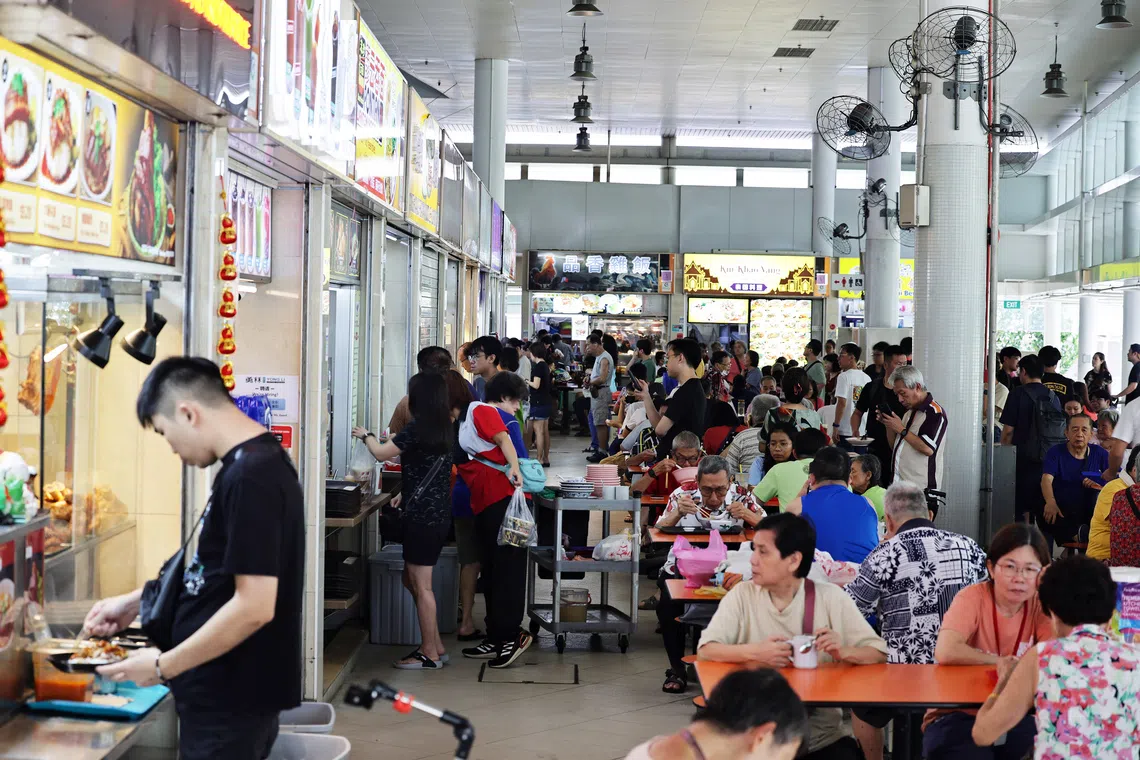Hawkers not expected to make loss from selling affordable meals: Goh Hanyan
Sign up now: Get ST's newsletters delivered to your inbox

Satisfaction levels for various aspects of SEHCs have been higher than 80 per cent based on NEA’s surveys between 2021 and 2024.
ST PHOTO: KELVIN CHNG
Follow topic:
SINGAPORE – Hawkers are not expected to make a loss from selling affordable meals, as they should have taken such meals into consideration when negotiating their rent with operators, Senior Parliamentary Secretary for Sustainability and the Environment Goh Hanyan told Parliament on Sept 24.
Ms Goh distinguished the budget meals from a scheme at Bukit Canberra Hawker Centre that once required hawkers to provide free meals flagged concerns in August
WP MP He Ting Ru (Sengkang GRC) had asked whether the National Environment Agency (NEA) permitted hawker centre operators to contractually oblige hawkers to provide free meals, and for guidance on the appropriateness of such practices in future contracts.
Ms Goh said Bukit Canberra Hawker Centre was the only socially conscious enterprise hawker centre (SEHC) with the requirement to provide free meals, and the condition was made known upfront to stallholders.
Describing the scheme as well-intentioned with the purpose of providing an inclusive community dining option, she added: “Stallholders who decided to proceed with renting stalls at the centre... would have factored the costs into their business considerations.”
Mr Foo Cexiang (Tanjong Pagar GRC), Mr Louis Chua (Sengkang GRC), Mr Gerald Giam (Aljunied GRC), Mr Abdul Muhaimin Abdul Malik (Sengkang GRC) and Mr Ng Shi Xuan (Sembawang GRC) had also asked about the Government’s plans for SEHCs, introduced in 2011, and whether it will review the current approach.
Ms Goh said operators of such hawker centres are required to implement ways to keep food affordable as part of tender requirements. To date, SEHC operators have done so by making at least one “value meal” available at each stall, with stallholders given the flexibility to propose these food items, she added.
Ms Goh said that operators explain the requirement of providing a “value meal” upfront to stallholders during the signing of tenancy agreements. “Operators will also review their value meal prices from time to time and have previously adjusted prices upwards based on feedback from stallholders.”
Mr Chua asked if NEA would set guidelines for affordable and free meals rather than have these conditions baked into contractual agreements.
Replying, Ms Goh said hawkers are not expected to make a business loss from affordable meals.
Value meals account for 5 per cent to 20 per cent of the number of meals a hawker sells, she noted.
Ms Goh said operators are required to conduct quarterly feedback sessions with their stallholders. At these sessions, which are also attended by NEA representatives, hawkers can raise concerns or ideas to improve the operations of the hawker centres.
This consultative approach has resulted in improvements, said Ms Goh, citing an example of an operator who would explore lower-cost options after receiving feedback on high gas costs.
She said that since 2018, the Government has put in place guidelines for tenancy agreements to safeguard the interests of stallholders. These include not requiring stalls to open for more than five days each week and limits on the amounts that operators can charge stallholders for contractual breaches.
NEA officers are usually present at the signing of tenancy agreements and they would ask operators to review clauses if necessary.
Beyond guidelines, operators are given the flexibility of adding their own terms, based on operational needs, but they are required to explain these additional terms clearly to stallholders.
Ms Goh said: “As tenancy agreements are private arrangements between the operators and stallholders, it would not be appropriate for NEA to mandate public disclosures.”
Mr Foo also asked if the ministry would review the practice of some hawkers being required to pay for discounts
Ms Goh pointed out that operators bear the cost of developing these apps, as well as marketing and publicity efforts. Stallholders bear a portion of the costs by providing discounts in return for increased sales, she said.
Satisfaction levels for various aspects of SEHCs have been higher than 80 per cent based on NEA’s surveys between 2021 and 2024, she said, adding that stall occupancy rates are at about 96 per cent.
She said: “Moving forward, we will continue to improve the SEHC management model through constructive engagement with stakeholders and continuous refinements to better serve the interests of our community.”


